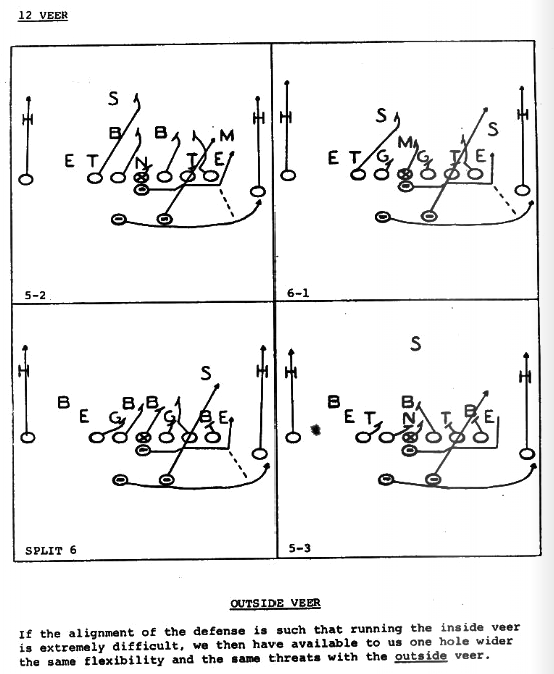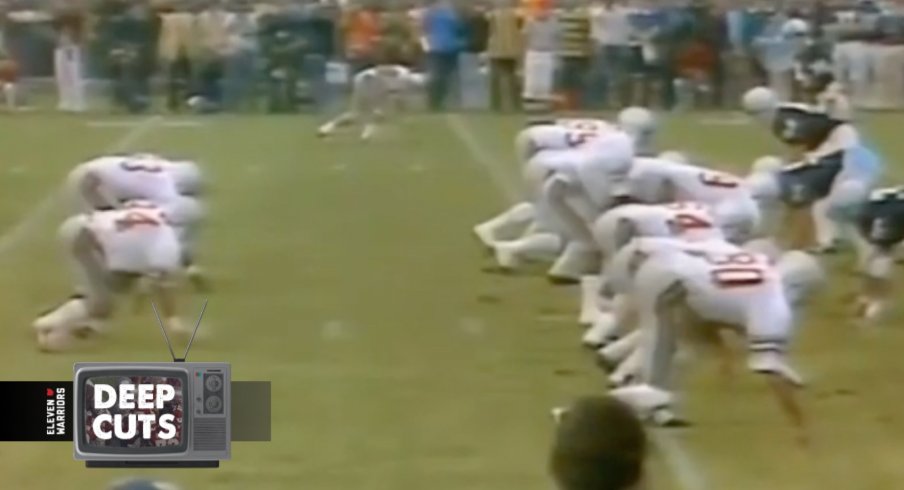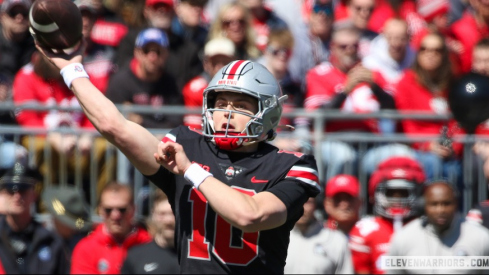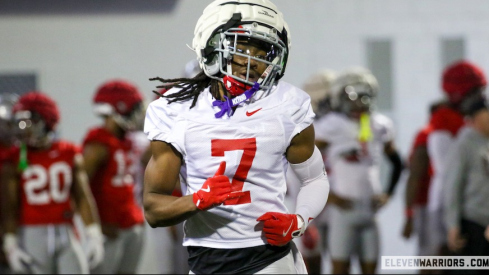Strange as it may sound, our story begins in Houston, Texas.
Fresh off the departure of the program's most decorated player, halfback Archie Griffin, as well as an All-American quarterback in Cornelius Greene, Woody Hayes was at a bit of a crossroads in 1976. Sure, bruising fullback Pete Johnson remained in the backfield for one more season, but the legendary coach knew he couldn't rest on his laurels.
While Griffin had been busy winning back-to-back Heismans and making annual trips to Pasadena in the early-70s, Bill Yeoman had turned the Houston Cougars into an offensive powerhouse. The former Michigan State assistant took over in 1962, and by 1976, had earned the program an invitation to play with the big boys of the Southwest Conference.
| #2 |
 |
Ohio State | 12 |
| #7 |
 |
Penn State | 7 |
Yeoman had the attention of nearly every fellow coach by this time thanks to an innovative, option offense that would define the sport for decades. Though its origins still remain a bit unclear, the College Football Hall of Fame credits Yeoman with inventing the triple-option, a concept that took many different forms and can still be seen today in the Flexbone offenses at the service academies and the RPOs seen in Shotgun-Spread systems.
The basics of the play are well-known. The quarterback first reads the defender lined up over the offensive tackle. If that defender stays outside, the QB simply hands off to the "dive" player, who rams the ball inside for as many yards as he can.
If that defender does fill the inside gap, then the QB pulls the ball from the belly of the dive player and runs straight at the end man on the line of scrimmage. If that end man crashes down to tackle the QB, then the ball is simply pitched outside to the trailing runner who tries to turn the corner for a big gain.

Yeoman believed that running the play over and over throughout the course of a game not only limited the number of adjustments a defense could make, but it also strained the opponent's will.
Many teams had adapted Yeoman's concept to fit a number of formations, from the I to the Wishbone, and Woody had even incorporated it into his T-formation sets with Greene acting as the maestro in front of Griffin and Johnson during previous seasons. But as the Buckeyes entered a new era in 1976, they looked to Yeoman's split-back set as the way to best incorporate new QB Rod Gerald and halfback Jeff Logan.
After calmly dispatching Michigan State in the season opener, tallying over 400 rushing yards with Yeoman's triple-option, the Buckeyes headed to State College for a rare battle with then-independent Penn State. Though Joe Paterno had assembled a top-ten squad and a bruising, 4-4 defense, Hayes had no intention of going away from his deep-held belief in running the football.
Though Johnson's massive frame remained in Hayes' backfield, the contest began with Logan often acting as the Dive man, working hard for yardage between the tackles while Johnson looked for the rare pitch outside.
The Buckeyes slowly hammered the Nittany Lion defense early with dive after dive, while Gerald only occasionally kept for himself and never once pitched it outside before halftime.
But as Yeoman predicted, eventually the Penn State defense broke.
Paterno's front was caught trying to execute a stunt that forced the backside linebacker to come all the way across the formation to stop Logan on a dive. After running through that flailing tackle attempt, there was nothing but green grass in front of the North Canton native.
Despite all of Logan's hard work getting Ohio State near the goal line, his touches were rare at that end of the field. As Logan told 11W's Dan Hope recently, this wasn't a surprise.
"If we’re gonna score touchdowns, we better do it from outside the 20-yard line, Logan said. "Because as soon as we got in the red zone, Woody would put us in the robust offense which was that full-house backfield, and the only guy carrying the football inside the 20-yard line most likely was Pete Johnson"
Much as he's done in previous seasons with Griffin and Greene manning his backfield, Hayes reverted to his tried-and-true T-formation once his team reached the red zone. After working hard to get near the goal line, the Buckeyes would essentially swap out offenses for the hard-hitting system upon which Hayes the old coach had made a name for himself two decades prior.
While Logan and the Buckeyes had largely dominated the time of possession through the first half, the led just 6-0 at the break thanks to a Gerald keeper around left end. Meanwhile, Paterno's offense had begun to gain some steam through the air, leading Hayes to reach deeper into his playbook in the third quarter.
Perhaps the plan had been in place all along, but upon taking possession in the second half, the Buckeye backfield lined up the way they had for the half-decade prior, with the running backs in an I-formation behind the QB and a receiver lined up on the wing. But while Hayes still ran plenty of triple-option plays from this look, the offense could also feature more traditional run concepts, such as this counter which pulled both guards around the left end to lead Logan.
With the wingback to one side, the Buckeyes could run traditional I-formation concepts but also essentially had three backs in the backfield. This allowed the triple-option to be modified so the tailback (Logan) took the dive handoff behind a lead block from the fullback (Johnson) while the wingback worked to be the pitch-man for Gerald outside.
Entering the fourth quarter, the score remained 6-0, but the visiting team had begun moving the ball at will by alternating between split-back and I-formation sets. After a long drive set up the Buckeyes near the goal line, a triple-option from the T-formation finally saw the ball go to the third option, with flanker Bob Hyatt taking the pitch around the edge untouched on what would be his only carry of the season.
Ohio State would fail to convert the ensuing two-point conversion attempt and Penn State would string together enough passes to find the end zone on the ensuing drive, making the score 12-7 midway through the fourth quarter. But with a diverse running game built around Yeoman's Split-Veer option attack, Hayes' team was able to run off 6 minutes of clock and essentially end the game.
Johnson may have been the most notable name in that backfield, finishing his career with a school record for points that would stand for nearly 3 decades. But on this day in Happy Valley, it was the new names in the Buckeye backfield that carried the visitors to victory.
Logan led all rushers with 160 yards on 25 attempts, despite never coming close to finding the end zone. Meanwhile, Gerald tallied 52 yards on 24 carries himself, though he'd complete just one of three pass attempts that afternoon to go along with multiple sacks.
Though the Buckeye ground game may have been a predictable one, it proved quite difficult to stop in this nationally televised contest between future rivals.
"Well, as a running back, I loved it," Logan told 11W. "Don’t waste the ball on wide receivers. But seriously, we had an unbelievable offensive line, and Pete Johnson was our fullback, so the ability to run Woody Hayes’ power offense, which limited the mistakes, limited the concern that Woody had in turning the ball over, I go back and watch the video of that and we were really boring and predictable, but we were powerful and efficient in terms of what we did."




